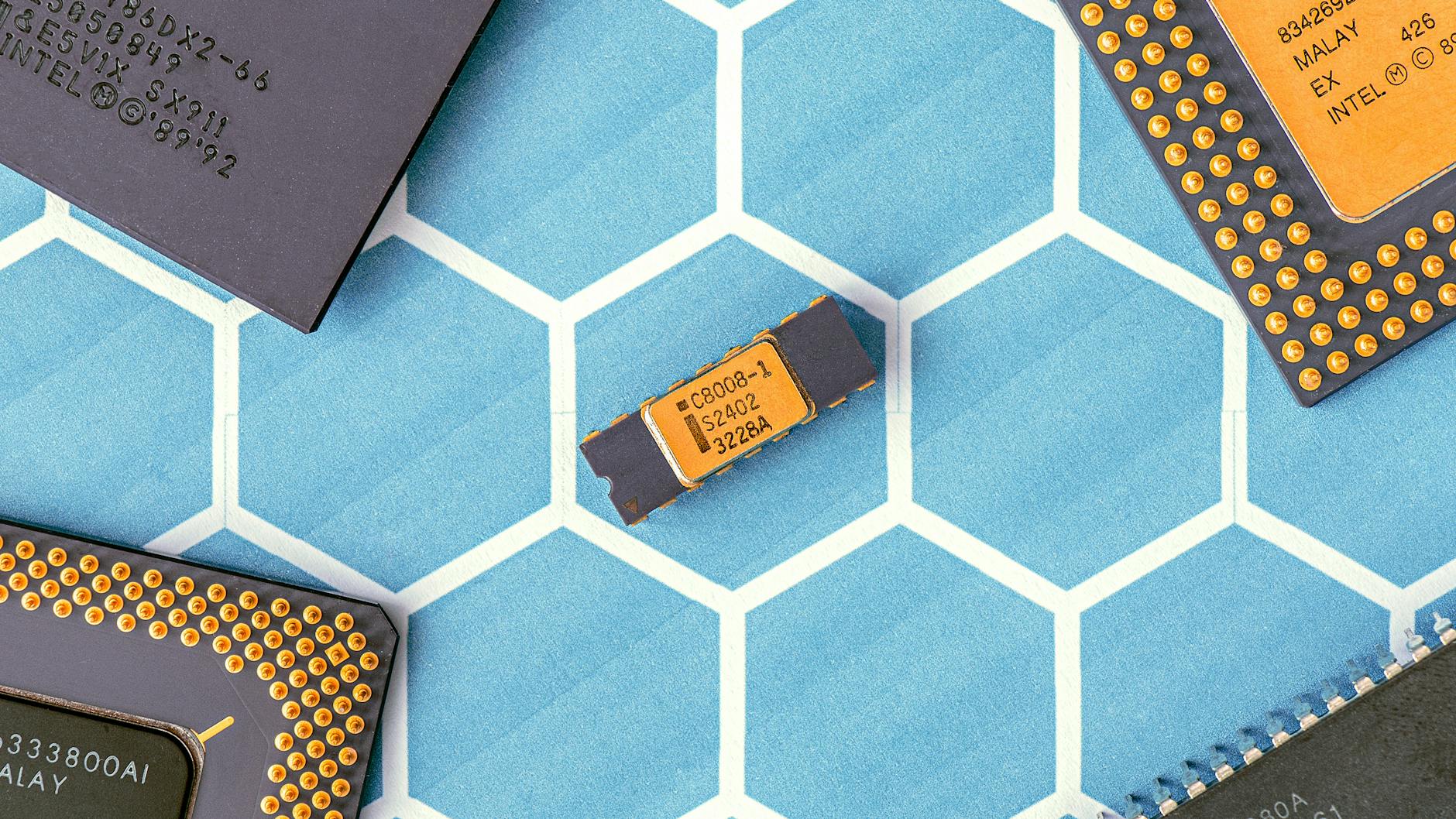Our Game-Changer: Revolutionizing Tomorrow with GPU Technology
Evolution of GPUs
GPU Origins
Remember when playing games meant choppy graphics and long waits? Not anymore, thanks to Graphics Processing Units (GPUs). Born to boost graphics in video games, these chips initially got their street cred by jazzing up 2D and 3D visuals. Back in the day, they were a bit basic with fewer cores, but mighty in their own right.
| Feature | Early GPUs | Modern GPUs |
|---|---|---|
| Core Count | 32 – 128 Cores | Up to 10,000+ Cores |
| Memory Bandwidth | 20 – 50 GB/s | 500 – 1000 GB/s |
| Clock Speed | 200 – 400 MHz | 1.5 – 3.0 GHz |
Remember NVIDIA and ATI (now AMD)? These were the folks who gave gamers and tech fans the first taste of GPU magic. Those early processors were like the Flintstones of the GPU family, making way for today’s sleek, muscle-bound devices.
GPU Advancements
These days, GPUs aren’t just the cool kids on the block for gamer folks. They’ve grown into multi-talented beasts that turn their hands to all sorts of tasks. From tackling video editing to crunching numbers for AI and machine learning, modern GPUs are like 10,000 tiny helpers working together, making them ideal for any job needing a lot of grunt work done fast.
As folks over at GeeksforGeeks point out, these parallel processing wonders are AI’s best buds. Core counts? They’ve doubled like clockwork every couple of years, supercharging AI processing. Memory bands have blown up by eight times, handling hefty data loads, and clock speeds are off the charts, zipping through AI algorithms like nobody’s business (Sesterce).
| Year | Core Count | Memory Bandwidth | Clock Speed |
|---|---|---|---|
| 2010 | 512 | 144.2 GB/s | 1.4 GHz |
| 2015 | 3072 | 336.5 GB/s | 1.6 GHz |
| 2020 | 4608 | 760.3 GB/s | 2.1 GHz |
The speed of GPUs has shaved tons of time off the clock in training and running AI models, a lifesaver for real-time needs like self-driving cars and quick language translations (Telnyx).
Looking ahead, folks are zeroing in on building GPUs that are brainy enough to handle AI like a pro, merging smart design and AI tech to rewrite the rules of what computers can do. This mash-up is driving AI’s ability to think on its feet, raising the bar and breaking boundaries like nobody’s business. Check out our sections on evolving gpu architectures and upcoming graphics card advancements for the scoop.
Getting a grip on how GPUs have morphed shows just how far we’ve come, with heaps of excitement about what’s around the corner as these tech wonders continue to rock our digital world.
Current Trends in GPU Technology
Hey there, tech enthusiasts! Today, we’re diving into the exciting world of GPU technology and the cool trends that are pushing the envelope. These changes promise to make gaming, AI, and other tech wonders faster and more efficient.
Mixing It Up with Heterogeneous Computing
Let’s break it down: heterogeneous computing’s the big cheese in GPU tech right now. Picture a squad where each member has their specialty – CPUs, GPUs, and maybe a few secret weapons called accelerators. This team can smash through complex tasks more efficiently and speedily. It’s like divvying up chores: the right tool for the job, every time.
Table: Teamwork Makes the Dream Work
| Component | Superpower |
|---|---|
| CPU | All-rounder, master of the usual stuff |
| GPU | The artist, great at juggling lots of things at once (and making them look good) |
| Accelerator | The specialist, kicking butt in AI and cryptography |
If you’re curious about how this dream team fights the forces of lag, hop over to our page on mixing and matching in GPU tech.
The Marvel of Advanced Architectures
Now, on to the building blocks of future GPUs. These architectures are the unsung heroes, designed to keep up with the hustle of today’s tech scene. One cool feature, Tensor Cores, is like having a gym buddy who always spots you – perfect for lifting those heavy AI weights. They turbocharge deep learning, making large simulations a breeze.
Table: What Makes These Bricks Better
| Feature | Superpower |
|---|---|
| Tensor Cores | Gives AI a workout boost |
| Parallel Processing Units | Multitasking pros |
| AI-Optimized Gears | Plays well with neural networks |
These nifty upgrades are making waves in the world of brand spanking new graphics cards, making your GPUs flex more muscle than ever before.
Shaking Up Memory
Hold on to your hats because memory is also getting a killer upgrade! With High Bandwidth Memory (HBM) and Unified Memory Architectures (UMA) stepping into the scene, GPU performance is taking off like a rocket. HBM stacks up data transfer speeds like pancakes, and UMA lets different processors cozy up to the same memory for quicker response times.
| Memory Type | Superpower |
|---|---|
| High Bandwidth Memory (HBM) | Speeds everything up like a fast-track pass |
| Unified Memory Architectures (UMA) | Cuts down on wait times, cozy shared spaces |
With these memory magic tricks, tomorrow’s GPUs will be prepped for the avalanche of data from AI and machine learning, boosting not only power but also efficiency.
As we keep carving out new frontiers with these cool advancements, the doors to possibility fly open. From making games more thrilling to kicking AI research into high gear, or pushing the boundaries in the latest video tech geekiness, GPU technology’s future is as bright as a supernova.
For a deeper dive into where these paths might lead us, check out our thorough discussion on what’s coming next in graphics cards.
Future Predictions for GPUs
The spotlight on GPU technology shines as bright as ever, with promises to jazz up gaming and computing in ways that might just knock our socks off. Let’s chew the fat about three jaw-dropping areas: mega processing power, going green with energy efficiency, and the push to edge computing.
Increased Processing Power
We’re on the brink of GPU wonders that’ll blow today’s performance outta the water. As AI and gaming keep demanding the universe, GPUs are gearing up with more muscle. Think more cores, jacked-up clock speeds, and heavyweight parallel processing (GeeksforGeeks).
| Feature | Current Average | Future Prediction |
|---|---|---|
| Core Count | Up to 6,000 cores | Up to 10,000+ cores |
| Memory Bandwidth | 750 GB/s | 1,500 GB/s |
| Clock Speed | 1.5 GHz | 3.0 GHz |
Imagine cranking up your game load times or AI models running smoother than a hot knife through butter. It’s like a caffeine shot for gamers and tech wizards alike. Find out more by checking out our scoop on next-generation graphics cards.
Energy Efficiency Advancements
Going green isn’t just a bumper sticker, it’s the future for GPUs. Everyone’s got an eye on weaving energy-smart tech with unyielding performance. AI-savvy GPUs are gonna be the deal-breaker here, focusing on draining less power yet still conquering big jobs (GeeksforGeeks).
| Efficiency Metric | Current Average | Future Prediction |
|---|---|---|
| Power Consumption | 300 Watts | 150 Watts |
| Performance per Watt | 1.5 TERAFLOPS/Watt | 3.0 TERAFLOPS/Watt |
Less juice, more power—it’s a win-win, whether you’re firing up a game rig or crunching data in the cloud. For more on these tech tweaks, pop over to our take on evolving GPU architectures.
Expansion of Edge Computing
Say goodbye to sluggishness, edge computing is here to save the day. By shoving the compute power closer to where it’s needed, we’re slicing down delays and beefing up real-time processing. And boy, does this hit the sweet spot for AI and gaming. (GeeksforGeeks).
GPUs of the future will become the go-to for edge computing mavericks, letting developers slap their AI blueprints right at the source. Picture it: Self-driving rides, lightning-fast game rendering—it’s the new frontier folks.
Want more insights into these low-latency marvels? Peek at our article on upcoming graphics card advancements.
The blend of supercharged processing, cutting-edge energy use, and expanding horizons in edge computing marks a thrilling chapter for GPU tech. We’re talking performance leaps that’ll change the game in AI, gaming, and so much more. Dive into our treasure chest of knowledge on latest video card innovations for all the juicy details.
GPU Technology and AI Integration
We can’t help but be excited about what’s next for GPUs, especially as they join forces with Artificial Intelligence (AI). Once just about making graphics pretty, now GPUs are behind the scenes, cranking up AI tasks and giving various industries a serious boost.
GPU’s Role in AI
Why are GPUs such big shots in AI? It all boils down to parallel processing – they juggle a bunch of tasks at once. It’s like having a whole team working on a project rather than just one person, speeding things up, especially when training and running those smarty-pants AI models (GeeksforGeeks). As AI and machine learning get snazzier, GPUs are being crafted with AI duties in mind.
| Feature | Benefit |
|---|---|
| Parallel Processing | Fast AI Training |
| High Computational Power | Handles Complex Models |
| Optimized AI Architecture | Top-Notch Performance |
NVIDIA’s Blackwell Platform
Enter NVIDIA’s Blackwell architecture, a real superstar in the GPU arena. This platform throws in six majorly cool technologies that juice up computing speeds. It’s creating waves in sectors like data crunching, engineering smarts, and designing gadgets, all the while cutting down on costs and energy use compared to the older models (NVIDIA News).
| Technology | Impact |
|---|---|
| Engineering Simulation | Better data accuracy |
| Generative AI | Speedier model creation |
| Quantum Computing | Boosted computational efficiency |
Curious about how architecture is changing? Peek at our article on evolving gpu architectures.
Utilizing Multi-Chip Modules
Next up, Multi-Chip Modules (MCMs) are cranking up GPU power levels. By smooshing multiple GPU brains into one setup, MCMs are essentially doubling or tripling the muscle power. That’s a big deal for handling hefty AI processes, paving the way for crafting and training beefier, smarter AI models (Sesterce).
| Benefit | Description |
|---|---|
| Increased Cores | More oomph for calculations |
| Expanded Memory Capacity | Holds more data juiciness |
| Enhanced AI Performance | Smooth sailing for model training |
Looking for more on what’s next for GPUs? Don’t miss out on our article about upcoming graphics card advancements.
With GPUs and AI shaking hands, we’re seeing technology speed up and get sharper like never before. Our intrigue with where GPUs are headed is only matched by the wild potential they pack.
Scope out the latest video card innovations to keep your tech knowledge on point as things keep zooming forward.
Diverse Applications of GPUs
You thought GPUs were just about gaming? Not even close! Let’s have a chinwag about where these trusty chips are really making waves—video editing, film-making magic, and the smarty-pants world of machine learning.
Video Editing and Processing
When it comes to video editing, GPUs are the trusty sidekick that speed things up like nobody’s business. They make light work of the heavy lifting—think video encoding and rendering—without making your whole system hit the slow-mo button. If you’re piecing together epic high-res vids with those snazzy effects, there’s no escaping the need for a GPU’s grunt.
For more fun stuff on GPUs, don’t miss our article on newest video card discoveries.
| Task | Time Saved by GPU (%) |
|---|---|
| Rendering | 70% |
| Encoding | 60% |
| Applying Effects | 55% |
| Real-time Editing | 50% |
Data thanks to OpenMetal.
GPUs in Film Production
Hollywood’s got GPUs as their secret weapon! From mind-blowing 3D graphics to animations, these little chips kick it up a notch. Artists, armed with GPU-powered gear, whip up that jaw-dropping detail and realism—stuff dreams are made of.
For film pros, GPUs are the backbone—speeding up everything from pre-viz to the final cut, letting filmmakers unleash their imagination and creativity.
Curious about where GPU tech is headed in film? Check out our piece on new graphics card ideas.
GPU Applications in Machine Learning
Machine learning (ML) and GPUs? Like peanut butter and jelly. Their parallel processing mojo means models train faster, which is key for real-time wonders like driverless cars and instant translation.
| Application | Training Time Reduction (%) |
|---|---|
| Image Recognition | 80% |
| Natural Language Processing | 75% |
| Autonomous Driving | 85% |
| Fraud Detection | 70% |
Shoutout to Telnyx for the numbers.
With GPUs, ML dives through data and spots patterns like a boss. This superpower is shaking up industries like healthcare, finance, and even helping sort your emails!
Want more nuggets of wisdom on GPUs in ML? Visit our write-up on exciting GPU architecture changes.
So, while gaming might’ve brought GPUs into the spotlight, they’re now stealing the show across all sorts of industries. Lap up more about the latest in GPU tech if you’re keen to keep your finger on the pulse.
Gaming Enhancements with GPUs
Get ready for some mind-blowing changes in how graphics show up in our favorite video games. With GPU technology taking massive leaps forward, it’s like Christmas morning for gamers. Let’s chat about some of the cool stuff that’s shaking up the scene.
DLSS and Frame Generation
Ever wish you could boost your game’s graphics without forking out for the latest shiny gear? Meet NVIDIA’s DLSS. This smart tech uses AI to take your game’s graphics and make them look slick without needing hardware that costs more than your rent. And let’s not forget Frame Generation—making those games from ‘way back when’ look and feel buttery smooth, even when they used to chug along at just 30 FPS (Solent Way Computers).
| Thing | What It Does | Perfect For |
|---|---|---|
| DLSS | Boosts frame rates and visuals | Big-fancy games |
| Frame Generation | Doubles frame rate | Classics and oldies |
For extra nerdy details, peek at our piece on next-gen graphics cards.
AMD’s FidelityFX Super Resolution
Enter AMD’s FSR. This open-source wiz kid is all about jazzing up your gaming quality and speed. And the best part? It doesn’t play favorites—it works on lots of different graphics cards. So, no shame in having an older rig, you can still get some stunning visuals without throttling your performance (Solent Way Computers).
FSR shines for folks who want a peppier game experience on those trusty but less flashy cards.
Peek at more gaming tech on our latest video card innovations page.
VRAM Requirements and Ray Tracing
Okay, so modern games are getting a bit greedy with their VRAM demands. If you’re gaming in 1080p, you can chill with 4-6GB. But step it up to 1440p or the full glory of 4K and you better have at least 8GB to keep things running smoothly. And that ray tracing magic? It’s making light, shadows, and shine way more lifelike with the help of NVIDIA’s RTX cards (Solent Way Computers).
| Resolution | VRAM Needed |
|---|---|
| 1080p | 4-6GB |
| 1440p | 8GB+ |
| 4K | 10-12GB+ |
With games leaning into ray tracing’s dazzling tricks, the future’s looking bright (literally!) for game graphics.
Check out more with upcoming graphics card advancements and evolving gpu architectures.













